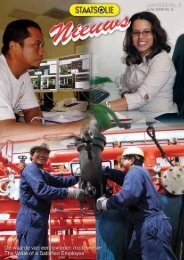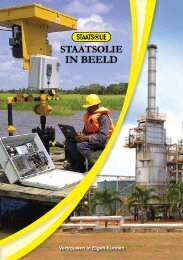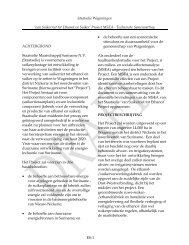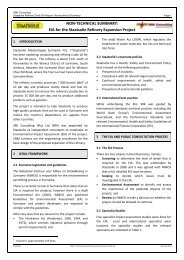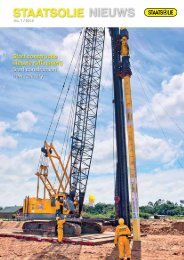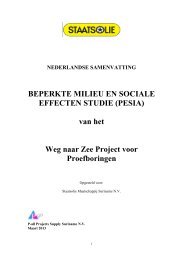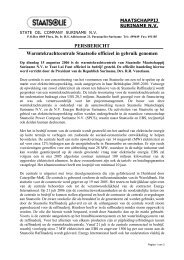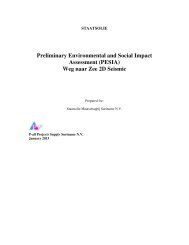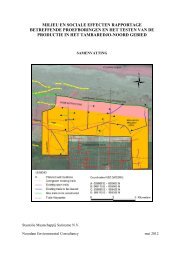concept EIA-rapport - Staatsolie
concept EIA-rapport - Staatsolie
concept EIA-rapport - Staatsolie
You also want an ePaper? Increase the reach of your titles
YUMPU automatically turns print PDFs into web optimized ePapers that Google loves.
SRK Consulting: Project No: 439414 <strong>Staatsolie</strong> Pipeline <strong>EIA</strong> – Draft <strong>EIA</strong> Report Page 90<br />
7 Conclusions and recommendations<br />
Pipelines are generally considered relatively safe and efficient conduits for fuel and are used<br />
worldwide under a wide range of conditions. The proposed <strong>Staatsolie</strong> pipeline is relatively smallscale<br />
compared to the major oil and gas pipelines and will be laid underground along most of its<br />
length. Consequently, the proposed <strong>Staatsolie</strong> pipeline is predicted to have few and limited impacts,<br />
which can be effectively mitigated.<br />
The <strong>EIA</strong> has examined the available project design information and drawn mainly on available<br />
(secondary) baseline data to identify and evaluate environmental (biophysical and socio-economic)<br />
impacts of the proposed <strong>Staatsolie</strong> pipelines. The <strong>EIA</strong> Report aims to inform decision-makers of the<br />
key considerations by providing an objective and comprehensive analysis of the potential impacts<br />
and benefits of the project and has created a platform for the formulation of mitigation measures to<br />
manage these impacts.<br />
This chapter presents the general conclusions that have been drawn from the <strong>EIA</strong> process and<br />
which should be considered in evaluating the project. It should be viewed as a supplement to the<br />
detailed assessment of individual impacts presented in Chapter 6.<br />
7.1 Principal findings<br />
There are a number of minor or less significant impacts associated with the pipeline. If<br />
recommended mitigation measures are adopted, these impacts are not expected to be significant<br />
nor long-term. They include groundwater, visual, air quality, noise and vibration, land and river use<br />
and climate change impacts.<br />
A summary evaluation of the potentially significant impacts that will result from the proposed project<br />
is presented below. Table 7-1 summarises the potentially significant impacts and their significance<br />
ratings before and after application of mitigation and/or optimisation measures. Relevant<br />
observations with regard to these impacts are:<br />
• Impacts on surface water quality in the Suriname River are most likely the result of construction<br />
activities, notably the planned disposal of surplus drilling mud into the Suriname River and runoff<br />
of sediments or contaminated water from construction sites. Impacts on water quality are<br />
expected to be limited due to the tidal nature of the river (resulting in vigorous mixing and dilution<br />
capacity), the expected small volume of pollutants and the absence of sensitive habitats in the<br />
area;<br />
• Impacts on terrestrial and aquatic habitat quality will be confined to the construction phase<br />
when vegetation clearing for drill pads and assembly areas and filling of land to extend drill pads<br />
into the river will occur. Impacts on habitat quality are expected to be limited as construction sites<br />
are very smalland located in highly disturbed areas of no conservation value;<br />
• The project will generate only limited employment. It is not expected that new employment will<br />
be created by the pipeline construction. Rather, existing employment at the contracted firms will<br />
be supported. Indirect employment generated through the (local) purchase of materials and<br />
services and expenditure in the local community is expected to be small; and<br />
• The movement of construction vehicles, laying out of pipeline strings in the river and the<br />
transport of construction materials, equipment and workers to and from the work sites may affect<br />
road and river traffic. However, the impact is considered limited as additional (local) road traffic<br />
due to the pipeline construction is expected to be minimal, and river-based activities related to<br />
the pipeline project are only locally restricted for short periods of time.<br />
REUT/DALC 439414_<strong>Staatsolie</strong>Pipeline<strong>EIA</strong>_Draft <strong>EIA</strong> Report_Final June 2012




